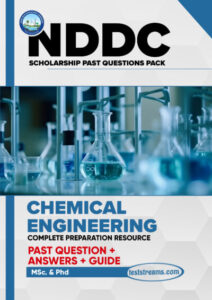NDDC Scholarship Chemical Engineering Past Questions And Answers [Free – Download]
Welcome to our blog post aimed at helping aspiring Chemical Engineering students excel in the NDDC Scholarship Chemical Engineering Test! The Niger Delta Development Commission (NDDC) provides scholarships to students in various fields, including Chemical Engineering, to support education and foster growth in the region. To aid your preparation, we have compiled a comprehensive guide that sheds light on the test structure, the significance of past questions, and sample questions with detailed answers to boost your confidence.
The NDDC Scholarship Chemical Engineering Test evaluates candidates’ grasp of fundamental concepts, problem-solving abilities, and knowledge in Chemical Engineering. The examination typically covers core topics like mass and energy balances, thermodynamics, chemical reaction engineering, process design, and safety protocols.
What Makes Our NDDC Scholarship Past Questions Stand Out?
- Comprehensive Coverage: Our collection spans multiple years, ensuring that you’re well-prepared for any surprises the exam might throw your way.
- Detailed Answers: Each question is accompanied by a comprehensive answer guide, allowing you to learn from your mistakes and reinforce your knowledge.
- Exam-Relevant Content: Our team of experts has painstakingly compiled the most relevant topics and questions that align with the NDDC Scholarship exam syllabus.
About NDDC Scholarship Test Style and Format (Updated)
NDDC overseas scholarship test was conducted by Cinfores-Ltd, between 2010 and 2015. Since 2016, the tests are now conducted by MEIL (MARG Educational International Limited).
The test usually comprises of 2 sections –
1. General questions which everyone will have to sit, and
2. Discipline-based questions.
For example, candidates in Engineering and Science related disciplines could take a mix of science-based questions like maths, English, physics, and chemistry for part 1, then discipline-specific questions for part 2.
2016 and 2017 tests contained more discipline-specific tests and English language tests as general papers. The test usually lasts between 30 to 60 minutes.
sample question for Chemical Engineering
Question 1: What is the principle of mass balance used for in chemical engineering?
A. To calculate the amount of profit from a chemical process
B. To determine the energy required for a chemical reaction
C. To track the flow of mass into and out of a chemical process
D. To estimate the reaction rate of a chemical reaction
Answer : C. To track the flow of mass into and out of a chemical process
Question : Which type of chemical reactor operates at a constant volume and allows no mass exchange with its surroundings?
A. Batch reactor
B. Continuous stirred-tank reactor (CSTR)
C. Plug flow reactor (PFR)
D. Packed bed reactor
Answer : A. Batch reactor
Question 3: What is the primary objective of process control in chemical engineering?
A. To increase the complexity of chemical processes
B. To reduce the safety measures in chemical plants
C. To optimize the production of chemicals
D. To minimize the environmental impact of chemical processes
Answer : C. To optimize the production of chemicals
Question 4: Which unit operation is used to separate components of a liquid mixture based on their boiling points?
A. Distillation
B. Filtration
C. Extraction
D. Crystallization
Answer: A. Distillation
Question 5: What does the term “yield” refer to in chemical engineering?
A. The amount of reactants used in a chemical process
B. The amount of energy required to initiate a chemical reaction
C. The percentage of desired product obtained from a chemical reaction
D. The rate at which reactants are consumed in a chemical reaction
Answer : C. The percentage of desired product obtained from a chemical reaction
Question 6: What is the purpose of a PFD (Process Flow Diagram) in Chemical Engineering?
A. To provide detailed information on equipment design and dimensions.
B. To indicate the sequence of operations in a chemical process.
C. To describe the material balance and energy balance of a chemical reaction.
D. To calculate the overall efficiency of a chemical plant.
Answer : B. To indicate the sequence of operations in a chemical process.
Question7: In a distillation process, which component typically accumulates at the top of the column?
A. Lighter components with lower boiling points.
B. Heavier components with higher boiling points.
C. Catalysts used to accelerate the reaction.
D. Inert gases that do not participate in the process.
Answer : A. Lighter components with lower boiling points.
Question 8: What does the term “Reynolds number” represent in fluid mechanics?
A. The pressure drop across a fluid flow.
B. The flow rate of the fluid in a pipe.
C. The ratio of inertial forces to viscous forces in the fluid flow.
D. The density of the fluid.
Answer: C. The ratio of inertial forces to viscous forces in the fluid flow.
Question 9: Which type of heat exchanger uses both parallel and counterflow paths for the hot and cold fluids?
A. Shell and tube heat exchanger.
B. Double pipe heat exchanger.
C. Plate heat exchanger.
D. Finned-tube heat exchanger.
Answer: A. Shell and tube heat exchanger.
Question 10: What is the purpose of a catalyst in a chemical reaction?
A. To increase the activation energy of the reaction.
B. To reduce the reaction rate.
C. To decrease the efficiency of the reaction.
D. To increase the reaction rate without being consumed.
Answer 11: D. To increase the reaction rate without being consumed.
Question 11: Which of the following unit operations is used to separate solid particles from a liquid stream by passing the mixture through a porous medium?
A. Distillation
B. Filtration
C. Absorption
D. Crystallization
Answer : B. Filtration
Question 13: In a heat exchanger, the fluid that gives off heat and cools down is called the:
A. Cold fluid
B. Hot fluid
C. Inlet fluid
D. Outlet fluid
Answer : A. Cold fluid
Question14 : What is the ideal gas law equation?
A. PV = nRT
B. PV = RT/n
C. PV = RT
D. P = nRT/V
Answer : A. PV = nRT
Question 15: What type of reactor provides the best temperature control during a chemical reaction?
A. Batch reactor
B. Continuous stirred-tank reactor (CSTR)
C. Plug flow reactor (PFR)
D. Packed bed reactor
Answer : B. Continuous stirred-tank reactor (CSTR)
Question 16: What is the primary function of a catalyst in a chemical reaction?
A. To increase the activation energy of the reaction.
B. To decrease the rate of the reaction.
C. To increase the yield of the products.
D. To provide a new pathway with lower energy barriers for the reaction to proceed.
Answer: D. To provide a new pathway with lower energy barriers for the reaction to proceed.
Question 17: Which type of pump is commonly used for pumping high-viscosity fluids in Chemical Engineering processes?
A. Centrifugal pump
B. Reciprocating pump
C. Diaphragm pump
D. Gear pump
Answer : D. Gear pump
Question 18: What is the main function of a distillation column in Chemical Engineering processes?
A. Mixing and blending of different chemicals.
B. Heating and cooling of reactants during a reaction.
C. Separation of components based on their boiling points.
D. Filtration of solid particles from a liquid stream.
Answer 19: C. Separation of components based on their boiling points.
Question 20: Which law of thermodynamics deals with the conservation of energy and its transformation in Chemical Engineering processes?
A. Zeroth law
B. First law
C. Second law
D. Third law
Answer : B. First law




